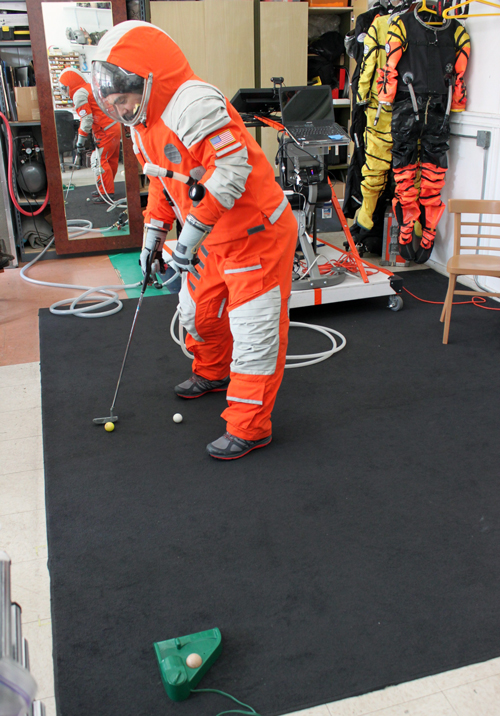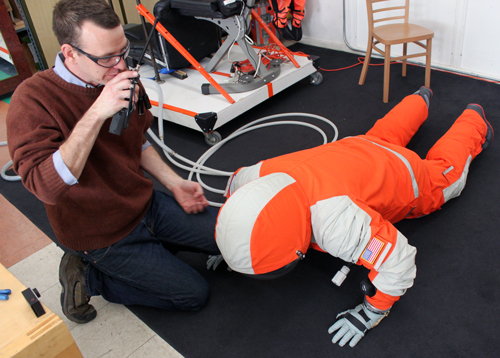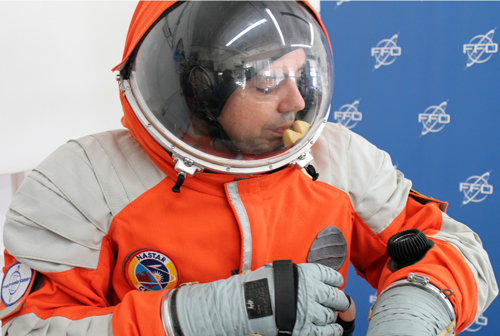Posey's Moonshot
Overcoming Spacesuit Anxiety During Astronaut Training
Spacesuits are heavy, claustrophobic and hot -- an uncomfortable combination for many would-be astronauts. Here's how Brien came around to the idea of wearing one.
One of the things most people probably don't know about spacesuits is that they are notorious for causing anxiety, especially when someone is trying on a spacesuit for the first time.
Since 2015, I have worn a spacesuit more times than I can count, and I now feel as comfortable and confident in a spacesuit as I do in my normal clothes. It wasn't always that way, though; I was more than a little bit nervous when I wore a spacesuit for the first time. I had some good reasons behind the way that I was feeling. Long before I ever had the opportunity to put on a spacesuit, I heard horror stories of people having extreme panic attacks or claustrophobic episodes while sealed inside a spacesuit. In fact, I once watched a BBC documentary in which the host went through several astronaut training exercises. Despite his enthusiasm, he experienced a bad case of claustrophobia when he was sealed inside a spacesuit for the first time.
In all fairness, I have never experienced panic attacks, nor am I claustrophobic. Even so, I was deeply concerned about putting on a spacesuit. For whatever reason, I have always had an aversion to wearing shirts with long sleeves. Throughout most of my childhood and up until I began training to go to space, I had only worn shirts with long sleeves on the rarest of occasions. Most of the time, I wouldn't even wear a coat in the winter because jackets have sleeves. I can't really explain this aversion. Sleeves just always made me feel confined. Wearing sleeves never caused me to have a panic attack or anything like that, but to say that I was comfortable in them would have been a lie (at least back then).
The fact that so many people who have no problems wearing jackets or long-sleeved shirts have had difficulties with spacesuits made me more than a little concerned. Not only would it have been super embarrassing to put on a spacesuit and suffer a claustrophobic episode, it would have ended my chances of ever becoming an astronaut. After all, you can't be an astronaut if you can't tolerate wearing a spacesuit.
Several weeks before I was scheduled to don a spacesuit for the first time, I began trying to desensitize myself. I found some tight, long-sleeved shirts and began wearing them for a couple of minutes at a time, gradually building up to the point where I could handle them for longer and longer periods. I still wasn't thrilled with the long sleeves, but I at least could wear them without issue (today, they don't bother me at all). I continued wearing long-sleeved shirts and heavy jackets right up until the day I was to try on a spacesuit for the first time.
The first type of spacesuit that I ever wore (and the type that I have logged the most hours in) was an intravehicular activity (IVA) suit. An IVA is designed to be worn inside of a spacecraft during launch and reentry. The suit will keep you alive if the vehicle were to depressurize, but it isn't the sort of thing you would wear outside on a spacewalk. For that, you would need an extravehicular activity (EVA) suit. EVA suits are heavier and more complex than IVA suits. I will write about my experiences with EVA suits in a future column.
Upon my arrival at the testing facility, I was given a brief overview of the suit and then asked to put on a comfort layer. This layer consisted of a spandex shirt and pants, some socks and gloves. As the name implies, the comfort layer is designed to keep you comfortable. It keeps the suit from rubbing blisters, and it also prevents your skin from being in direct contact with the clammy-feeling inner layer of the suit.
One of the things that was somewhat unique about my first time using a spacesuit was that I wasn't required to wear any bio-monitoring equipment. Normally, when I am wearing a spacesuit, I have various sensors beneath the comfort layer monitoring things like my pulse, respiration and blood oxygen saturation. (I would love to give you a detailed technical overview of the various spacesuit systems, but strict confidentiality rules surround commercial spacesuit technology, so I have to be careful what I say.) At any rate, once I had put on the comfort layer, it was time to put on the actual suit.
Getting into an IVA suit is quite a process. The suit is made a bit like an adult-sized onesie, so rather than putting on the top and bottom separately, you have to squeeze through an opening in the suit and contort yourself into a pretzel to get the suit on. (Again, I can't go into a lot of detail, but let's just say that there is a lot of bending and stretching involved.) Once you have the IVA suit on, it takes quite a while to get the suit ready to seal. There are dozens of adjustments that have to be made to make the suit fit properly. There are also seals to check, and hoses and cables that have to be connected. It's a really tedious process.
Finally, after what seemed like forever (but was probably more like 20 minutes), it was time to attach the gloves and close the visor. Even before I got to that point, I was already feeling a bit uneasy. The spacesuit gets really hot inside, and it's also much heavier than normal clothes. I had a feeling of being trapped inside the suit because I knew that I would never be able to take it off by myself. Even if I had asked to take the suit off, it would have taken several minutes for the technicians to get me out. To their credit, though, the people who were helping me suit up continuously asked me if I was doing OK.
Even though I was feeling a bit uneasy, I managed to tolerate the experience and, eventually, it was time to close the visor. That's when I expected to experience next-level claustrophobia. Surprisingly, though, the opposite happened. Immediately upon closing the visor, the suit became far more comfortable. The sudden increased comfort wasn't just a psychological thing. There is actually a reason why the suit became so much more tolerable with the visor closed. To understand why, however, you need to know a little bit about how spacesuits work.
Spacesuits do more than just give you air to breathe. If air were all that you needed to survive in space, then astronauts could just use scuba gear. Because space is a vacuum, you need air pressure around your body to survive. The spacesuit provides that air pressure. When you close the visor, the air flowing into the suit causes the suit to inflate like a balloon. The initial inflation is relatively minor because the suit only inflates to a point called vent pressure. Vent pressure isn't sufficient to keep you alive in space, but it is enough for you to get a sense of what the suit is like when pressurized.
When the suit begins to pressurize, two things happen. First, the suit actually gets bigger; it's literally like being inside of a balloon. In my case, the suit initially felt really confining, but at vent pressure the suit suddenly felt nice and roomy. At that point, the suit wasn't claustrophobic at all. The other thing that happens when you pressurize a spacesuit is that it becomes really stiff. This can make it tough to move around. You don't get much of a sense of this at vent pressure, but when the suit is fully pressurized, even small tasks become challenging. I was asked to do a few simple things like putting a golf ball or doing push-ups. I found both to be really cumbersome (and difficult) with a fully pressurized suit.
 Figure 1: Even something as simple as putting a few golf balls is tough in a pressurized suit.
Figure 1: Even something as simple as putting a few golf balls is tough in a pressurized suit.
 Figure 2: I never expected to be doing push-ups in a spacesuit.
Figure 2: I never expected to be doing push-ups in a spacesuit.
 Figure 3: I had the chance to fly a simulator while wearing the spacesuit.
Figure 3: I had the chance to fly a simulator while wearing the spacesuit.
As I said, vent pressure is a side-effect of closing the visor, but vent pressure alone isn't enough to keep you alive in space. To pressurize a spacesuit, you have to turn a regulator valve while watching a pressure gauge on your wrist. The gauge helps you inflate the suit to the correct pressure.
 Figure 4: This is the gauge that you use to monitor the suit's pressure.
Figure 4: This is the gauge that you use to monitor the suit's pressure.
When you pressurize a spacesuit, the pressurization can sometimes cause you to feel pressure in your ears. There is a device in the suit's neck ring (near my lips in Figure 4 above) that helps with this. You stick your nose in the V-shaped cutout, which holds your nose closed so that you can clear your ears. Over the years, I have found this device is also handy for scratching itches, and on more than one occasion I have also used it to reposition my microphone.
Even though I was more than a little nervous about using a spacesuit for the first time, it actually ended up being an awesome experience. It was one of those things that I never dreamed that I would actually get to do, and it far exceeded my expectations.
About the Author
Brien Posey is a 22-time Microsoft MVP with decades of IT experience. As a freelance writer, Posey has written thousands of articles and contributed to several dozen books on a wide variety of IT topics. Prior to going freelance, Posey was a CIO for a national chain of hospitals and health care facilities. He has also served as a network administrator for some of the country's largest insurance companies and for the Department of Defense at Fort Knox. In addition to his continued work in IT, Posey has spent the last several years actively training as a commercial scientist-astronaut candidate in preparation to fly on a mission to study polar mesospheric clouds from space. You can follow his spaceflight training on his Web site.